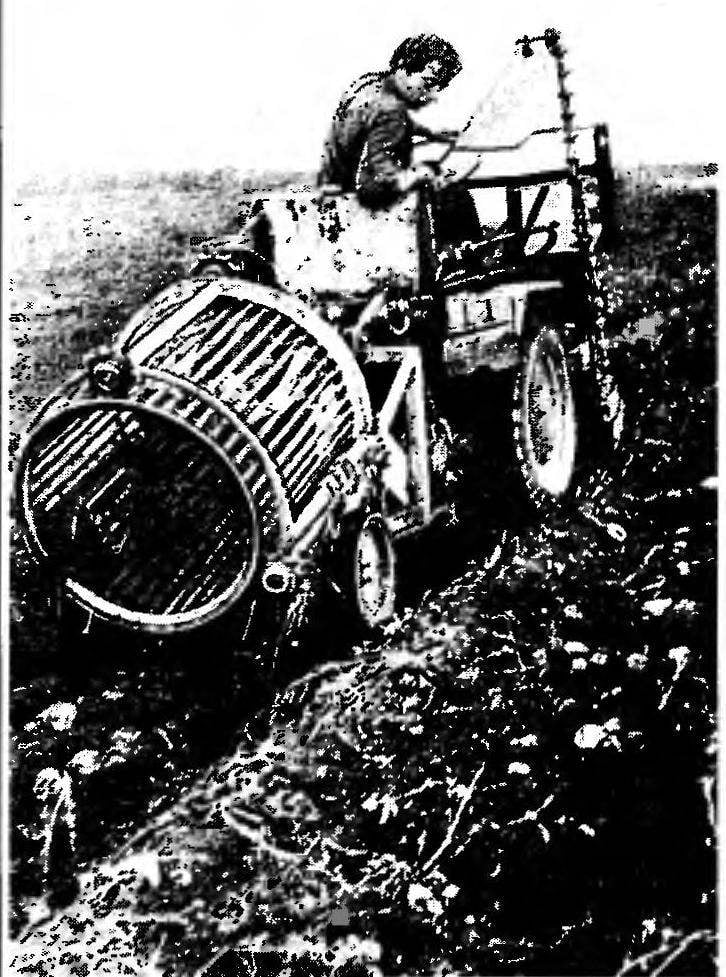The design of the latter (see Fig.) unauthorized. Consists of rigidly connected to each other cylindrical housings: bushing and Steel glass 30. They rotate on ball bearings leading and driven shafts of Steel 45 with prismatic impaled on a dowel with asterisks.
As already mentioned, the hub of the sprocket ^(Z1=17 and Z4=38) welded. The technology of manufacture of such with sufficient completeness has already been covered by the journal (see, for example, “M-K” 5’91). Moreover, as the hub for the Z4 can take a 25-mm segment of reinforced steel water-gas supply pipe 33,5×4.
Perhaps the most difficult to manufacture in a “home Studio” would be a drum-cleaner. It is based on two 1790 mm roller chains PRD-38. More precisely — 94 link located on their axes, and on the ends 47 of the rods with a protective (to prevent damage to the case tubers) shell in the middle. For tensioning the resulting “squirrel cage” and giving it a certain strength are two diene bent from 1 760-mm segments previously tempered steel area 20×20 mm. And the welding is performed after the tensioning of the chain.
But you can do two rims from a teen bike, if any you have at hand will be. On the bottom, using clamps “squirrel zero” stretched and welded item. For even greater rigidity of the structure can be reinforced by welding bars (10… 12 mm) grooved fittings.
“Squirrel cage” rotates, sandwiched between asterisks, located on the two axes and the shaft (fixed on the supporting diene with six welded plates). And axis, and the shaft is composite. Made with the same technology and represent the water-gas supply pipe of appropriate diameter, both sides have end caps welded from Steel 45.
Both axes not moving. Welded and base plates. But the driven sprockets on the axles rotate as the sleeve each mounted on the outer cage of the ball bearing 206 18S. The axes are welded to the base plates after the overmolding ball bearings with sprockets and adjusting their position. As for the shaft it revolves on bearings 180 206. And with it, rotate and leading asterisks, forcing him to spin and the drum itself. To “input” the leading star of four screws M10 flange with welded thereto a propeller with a fork.
Similar design has the shaft of the Elevator. Sprocket Z=14 rotate together with it, being planted on the prismatic dowel 8x7x45 mm and clamped from the sides by using spacer rings and sleeve, made of segments of cold drawn seamless steel tubes. Bevel gear welded to the shaft. Fit a pair of bearings in the gearbox housing is made deaf; fastening the housing to a support is carried out by bolts M1 2.
The input axis of the chain-rod conveyor resembles a threaded bolt M24 at the end. The axle is inserted into the hole of the casing on the left side. Then put spacer, and followed by the bearing from 180 205 is pressed onto its outer MAG sprocket Z=14. Put on the intermediate sleeve, the second bearing with sprocket, spacer ring. And after this is inserted the axle into the hole in the casing on the starboard side. The fastener ends a mystery M24 with washer.
Chain-bar tape — it is like a modified (stretched) “squirrel wheel”. It is made on the basis of two 1670 mm roller chains PRD-38. But bars here are somewhat less (44 PCs.). On top of that they are shorter “squirrel”: 275 mm. For the best slip tape on the slide, it is made of PTFE-4D. Enshrined it on the beam of the structural reinforcement using four screws MB with countersunk head. Located on the sides of the casing of the Elevator, the two slides serve as supporting surface for the chain links and protect it from damage.
It now remains to consider only the supporting-hub. But it is quite simple in design, and any difficulties in the manufacture hardly anyone can cause. The size and kreplenie parts of clear illustrations.
Six-year experience of operation of potato digger PKM and showed high reliability of this design and its advantages are revealed,compared,
for example, with a drum auger. While the kinematics has been so successful that the Krasnoyarsk combine plant decided to take it as the basis for the development of mass models. But that’s something not seen one. But we have to be nerazvorotlivy factory workers, as they used to.
E. SVIRIDOV, Krasnoyarsk, N. KOCHETOV, our special. Norr.
 “Hello, dear editors! Write “M” from 1969. Drawing magazine has fulfilled a number of projects. Pleased with them, that is, on all hundred. Particularly pleased with microtracker Amurchonok, has become my reliable assistant. He will plough the ground, and weeding perform, and hilling plants with it — no problem. And required construction works: load, which should drop the mortar (concrete) is thoroughly kneaded. I would like to equip your microtracker potato. The same as in the photo stitch “M-K” 5’89. If you publish the blueprints, then the fall will have time to do everything. To harvest potatoes to carry on their plot for not using old-fashioned shovels, and a modern, mechanized way.
“Hello, dear editors! Write “M” from 1969. Drawing magazine has fulfilled a number of projects. Pleased with them, that is, on all hundred. Particularly pleased with microtracker Amurchonok, has become my reliable assistant. He will plough the ground, and weeding perform, and hilling plants with it — no problem. And required construction works: load, which should drop the mortar (concrete) is thoroughly kneaded. I would like to equip your microtracker potato. The same as in the photo stitch “M-K” 5’89. If you publish the blueprints, then the fall will have time to do everything. To harvest potatoes to carry on their plot for not using old-fashioned shovels, and a modern, mechanized way.
